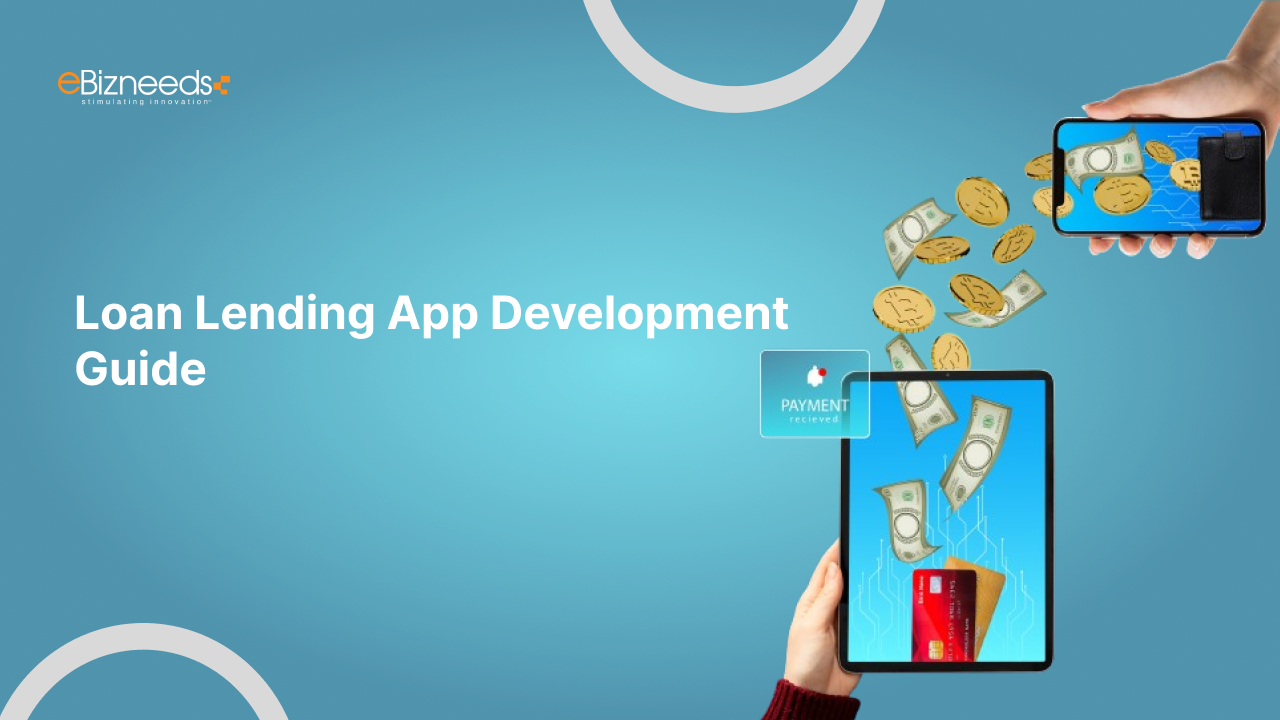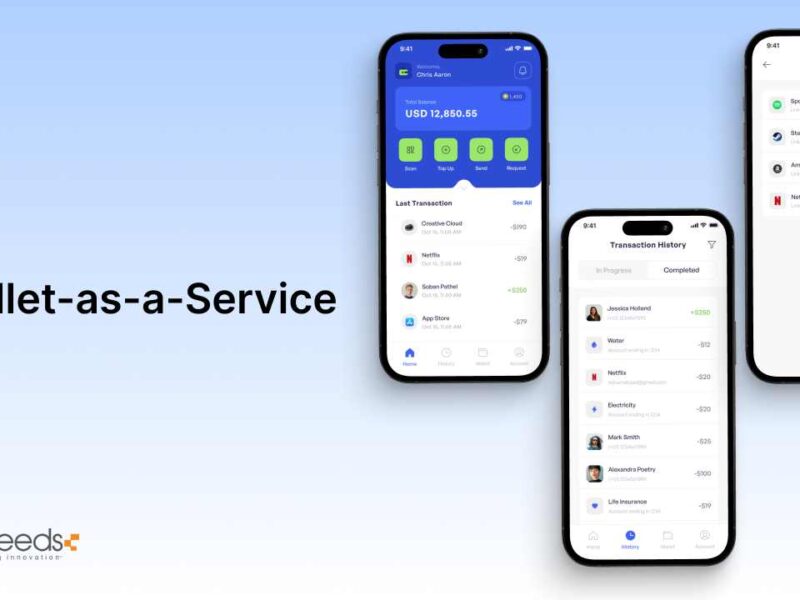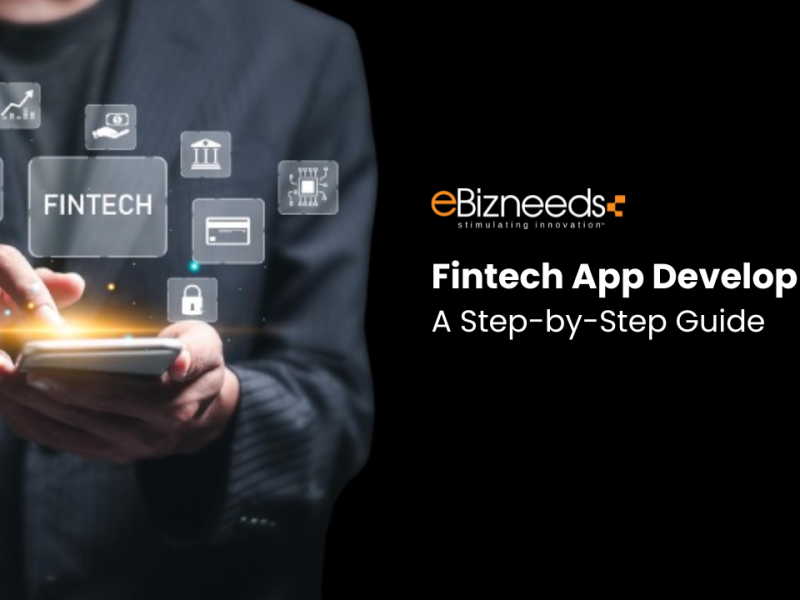The global lending market is rapidly shifting towards digital solutions, and loan lending apps are leading the way.
These apps streamline borrowing, offering users a seamless way to access funds without lengthy paperwork or multiple in-person visits.
With growing demand for faster loan approvals, businesses are investing in these apps to provide instant and secure lending services.
Whether you’re a financial institution or a startup, a loan lending app can transform your operations.
From peer-to-peer lending to traditional bank loans, these apps cater to various lending models, creating opportunities to serve different customer needs while maximizing profits.
Ready to learn how you can build one? Let’s dive in.
A Dive into Loan lending market
Here are some eye-opening statistics that showcase the growing demand for loan lending apps:
- The global digital lending market size was valued at $10.5 billion in 2023 and is projected to reach $20.3 billion by 2030, growing at a CAGR of 8.5%.
- 70% of borrowers now prefer digital channels for loan applications.
- Peer-to-peer lending platforms are expected to reach a market value of $705.81 billion by 2030.
- 60% of millennials have used at least one loan lending app in the past year.
- Digital lending has reduced average loan approval time from weeks to just 24-48 hours.
- Over 80% of banks are now planning to offer loan lending apps to stay competitive.
- By 2026, mobile devices will account for 72% of all digital loan applications globally.
- AI-powered loan lending apps have increased loan approval rates by up to 30% due to better credit analysis.
These figures highlight why businesses need to adapt to this digital transformation.



What is a Loan Lending App?
A loan lending app is a digital platform that connects borrowers and lenders, simplifying the loan process for both parties.
These apps enable users to apply for loans, check eligibility, upload documents, and receive funds, all through their smartphones.
For businesses, loan lending apps offer advanced tools to evaluate credit scores, verify documents, and automate approval workflows.
This reduces manual effort and enhances accuracy.
There are different types of loan lending apps, from peer-to-peer platforms to apps offered by traditional banks.
Each caters to unique lending models, making it easier for businesses to meet customer demands in a fast-paced financial ecosystem.
Looking for ways to develop one? Let’s break down how these apps work.
How Does a Loan Lending App Work?
A loan lending app streamlines the borrowing and lending process by leveraging technology.
Here’s a step-by-step overview of how it works:
For End-Users (Borrowers)
- Registration: Borrowers sign up and create a profile with basic details.
- Loan Application: They select the loan type, amount, and tenure, followed by submitting their request.
- Document Upload: The app allows users to upload required documents such as ID proofs, income statements, and credit reports.
- Credit Evaluation: The app uses AI algorithms to assess creditworthiness instantly.
- Approval & Disbursal: Upon approval, the loan amount is disbursed directly to the user’s bank account, sometimes within hours.
For Admins (Lenders)
- Loan Requests Dashboard: Lenders view all incoming applications and manage approvals through a centralized interface.
- Automated Credit Assessment: The app evaluates borrower profiles based on predefined parameters, minimizing human intervention.
- Document Verification: AI and OCR (Optical Character Recognition) tools automate document checks for faster processing.
- Loan Monitoring: Admins track active loans, repayment schedules, and defaults using real-time analytics.
- Collection Management: In case of delays, the app sends automated reminders to borrowers and assists lenders in recovery.
This efficient workflow enhances the user experience while making lending operations scalable and transparent.
Types of Loan Lending Apps
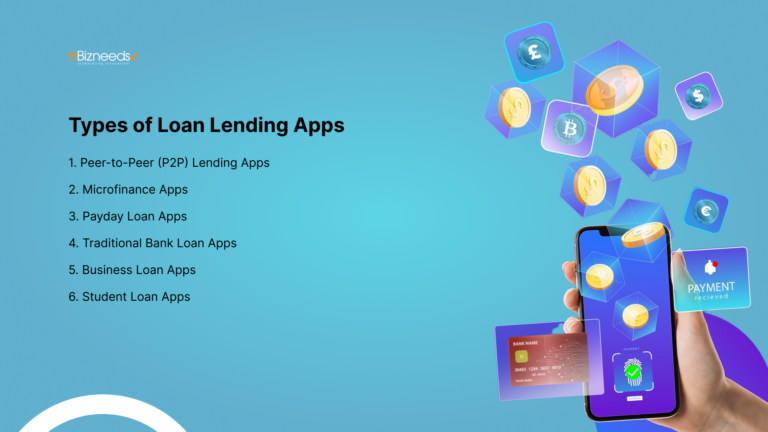


Loan lending apps are designed to cater to various lending models and financial needs.
Below is a detailed breakdown of the most popular types:
1. Peer-to-Peer (P2P) Lending Apps
P2P lending apps directly connect individual borrowers with lenders, bypassing traditional financial institutions.
These platforms are ideal for personal loans with competitive interest rates.
- Key Features:
- Borrower-Lender Matching: Automated algorithms match borrowers with lenders based on loan criteria.
- Dynamic Interest Rates: Rates are set based on borrower creditworthiness and market trends.
- Loan Diversification: Lenders can split their investments across multiple borrowers to reduce risk.
- Secure Transactions: Ensures transparency and accountability for both parties.
- Target Users: Individuals looking for unsecured personal loans, and lenders seeking higher returns.
- Example: LendingClub, a leading platform for P2P loans offering flexible terms and quick approvals.
2. Microfinance Apps
Microfinance apps are designed to provide small loans to underserved or low-income individuals who lack access to traditional banking.
These loans are typically used for personal or small business needs.
- Key Features:
- Simplified Applications: Minimal documentation requirements for faster approvals.
- Low Loan Amounts: Usually ranges between $50 and $500, depending on the region.
- Credit Building: Helps borrowers establish credit histories.
- Mobile Wallet Integration: Enables loan disbursal and repayments directly via mobile wallets.
- Target Users: Low-income groups, small-scale entrepreneurs, and farmers in emerging markets.
- Example: Branch, which provides microloans in countries like Kenya, India, and Nigeria.
3. Payday Loan Apps
Payday loan apps cater to individuals who need small, short-term loans to cover urgent financial needs before their next paycheck.
These loans usually come with high-interest rates but fast processing.
- Key Features:
- Instant Approval: Loans are processed and disbursed within minutes.
- Repayment on Payday: Automatic deductions are scheduled on the borrower’s payday.
- No Credit Checks: Ideal for users with poor or no credit history.
- Budgeting Tools: Some apps offer financial management tips to avoid repeat borrowing.
- Target Users: Individuals facing short-term cash flow issues, such as medical emergencies or unexpected bills.
- Example: Earnin, which allows users to access a portion of their earned wages before payday.
4. Traditional Bank Loan Apps
These apps are extensions of traditional banks, offering users a wide array of loan options.
They integrate with the bank’s existing infrastructure for added security and reliability.
- Key Features:
- Multiple Loan Types: Includes personal, home, vehicle, and business loans.
- Seamless Integration: Connected to user accounts for instant fund disbursal and repayment tracking.
- Robust Security: Adopts strong encryption for secure data handling.
- Real-Time Tracking: Borrowers can monitor loan status, repayment schedules, and EMI breakdowns.
- Target Users: Customers already associated with a particular bank or seeking traditional lending options.
- Example: Chase Mobile App, offering streamlined banking and loan services under one platform.
5. Business Loan Apps
These apps are tailored to meet the financing needs of businesses, especially small and medium enterprises (SMEs).
They provide capital for expansion, inventory management, and other operational needs.
- Key Features:
- Customizable Loan Products: Designed for various business use cases, such as working capital, asset purchase, or payroll management.
- AI-Powered Credit Scoring: Evaluates business performance, revenue, and creditworthiness.
- Repayment Flexibility: Offers extended repayment schedules and interest-only payment options.
- Detailed Analytics: Tracks loan utilization and business growth metrics.
- Target Users: Entrepreneurs, SMEs, and startups seeking operational or expansion funding.
- Example: Kabbage, a platform that supports small businesses with instant working capital loans.
6. Student Loan Apps
Student loan apps are specifically designed to help students finance their education by offering flexible repayment terms and lower interest rates.
- Key Features:
- Loan Customization: Based on course duration, tuition fees, and repayment capacity.
- Deferred Payment Plans: Allow students to start repayment after course completion.
- Co-Signer Support: Provides options for parents or guardians to act as co-signers.
- Education-Focused Tools: Includes resources like loan calculators and budgeting tips.
- Target Users: Students pursuing higher education or specialized training programs.
- Example: Sofi, offering flexible student loans with zero application fees.
Each of these apps caters to a unique audience, addressing different pain points in the lending process.
Whether you’re building for individuals, businesses, or specialized groups, the right app type can maximize your ROI and market impact.
Reasons to Develop a Loan Lending App
Investing in a loan lending app is a strategic move for businesses aiming to thrive in the evolving financial landscape.
Here are three major reasons why you should consider building a fintech app:
1. Meet Rising Consumer Expectations
Today’s customers demand speed, convenience, and transparency in financial services. Loan lending apps provide instant loan approvals, easy document uploads, and real-time updates—all accessible through a smartphone.
For businesses, this means capturing a tech-savvy audience that values efficiency. The convenience of digital lending can significantly enhance customer satisfaction and loyalty.
2. Unlock High Revenue Potential
The global lending market is booming, with digital lending predicted to grow at a CAGR of 8.5% by 2030. Loan lending apps enable businesses to earn through:
- Interest rates on loans.
- Processing fees for faster approvals.
- Late payment penalties.
With additional premium features, such as financial planning tools or credit score insights, businesses can create new revenue streams.
3. Automate and Scale Operations
Traditional lending processes are labor-intensive, involving manual credit checks, paperwork, and approvals. A loan lending app automates these tasks with AI and machine learning, reducing operational costs.
Moreover, automation enables businesses to handle a larger volume of loan requests without compromising on efficiency, making scalability seamless.
Building a loan lending app isn’t just an opportunity—it’s a necessity for businesses looking to stay competitive in the financial industry.
Who Should Build a Loan Lending App?
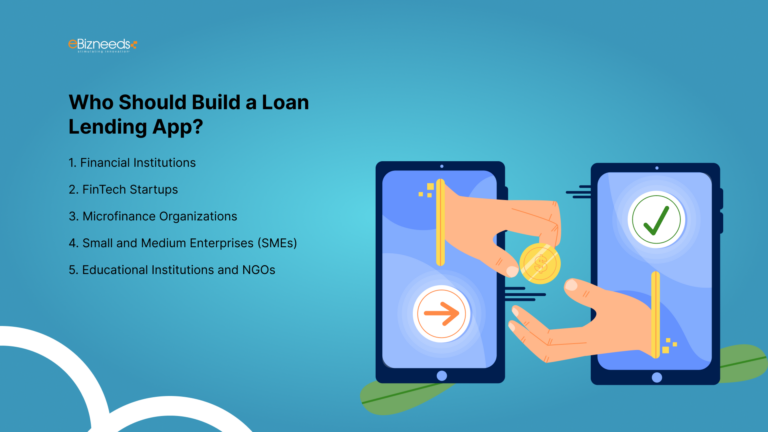


Loan lending apps are not limited to large financial institutions.
They cater to a wide range of businesses and industries that can leverage their potential.
Here’s who should consider developing one:
1. Financial Institutions
Banks, credit unions, and NBFCs (Non-Banking Financial Companies) can benefit significantly by digitizing their lending processes. These apps help them:
- Reach underserved markets.
- Improve loan disbursal speed.
- Compete with fintech companies.
2. FinTech Startups
FinTech startups are disrupting traditional lending by offering innovative solutions through loan lending apps.
They often target specific markets like peer-to-peer lending or payday loans, making it easier to attract niche audiences.
3. Microfinance Organizations
Microfinance companies can scale their operations and serve more customers by adopting digital lending apps.
Features like small loan disbursals, minimal documentation, and real-time credit checks make these apps ideal for microfinance businesses.
4. Small and Medium Enterprises (SMEs)
Loan lending apps allow SMEs to diversify their business models by offering short-term loans to clients or partners.
For example, e-commerce businesses can provide credit options for customers directly through their app.
5. Educational Institutions and NGOs
Apps designed for student loans or community development programs can help these organizations manage loan processes more efficiently.
They also enable better tracking and repayment management.
By investing in a loan lending app, these businesses can expand their customer base, streamline operations, and stay competitive in the growing digital lending market.
Wondering how the development process works? Let’s dive into the step-by-step breakdown!
Loan Lending App Development Process
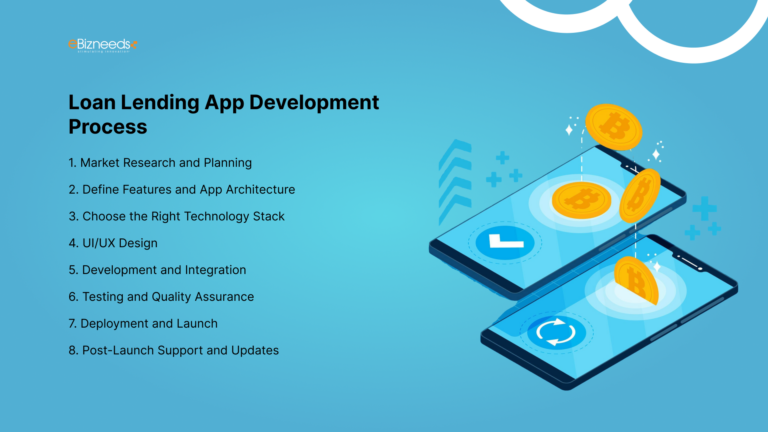


Developing a loan lending app is a complex but rewarding process that involves meticulous planning, state-of-the-art technology, and a user-focused approach.
Here’s a fully detailed step-by-step guide:
1. Market Research and Planning
Understand the Market Needs:
- Conduct surveys and interviews with target users to understand their pain points in borrowing and lending.
- Analyze trends in digital lending, such as AI-driven credit scoring and instant disbursal.
Segment Your Target Audience:
- Individuals: For personal, payday, or student loans.
- Small Businesses: For working capital or business expansion loans.
- Underserved Communities: Microfinance solutions for rural or low-income groups.
Competitor Analysis:
- Evaluate competitors’ strengths and weaknesses using SWOT analysis.
- Identify features that resonate most with users and where competitors fall short.
Define App Goals and KPIs:
- KPIs such as app downloads, loan approval rates, user retention, and repayment success rates.
Compliance and Legal Research:
- Research licensing requirements and financial regulations in target markets.
- Consider global standards like GDPR for user data protection, PCI-DSS for payment security, and AML (Anti-Money Laundering) compliance.
2. Define Features and App Architecture
Core Features:
- User Onboarding: Quick registration using email, phone, or social media.
- Loan Request: Customizable loan application forms for personal, business, or niche loans.
- Document Verification: AI-based Optical Character Recognition (OCR) for faster verification.
- Credit Scoring: Integrate APIs for real-time credit evaluation (e.g., Experian, Equifax).
- Loan Status Tracking: Notify users of application progress, approval, or rejections.
- Repayment Tools: Track due dates, send reminders, and offer automated payment options.
Advanced Features:
- AI-Powered Chatbots: For personalized loan advice and 24/7 customer support.
- Fraud Detection: Machine learning algorithms to identify fraudulent applications.
- Multi-Tier Admin Panel: Separate dashboards for admins, loan officers, and support staff.
- Real-Time Analytics: Dashboards for lenders to monitor performance metrics like repayment rates and borrower demographics.
System Architecture:
- Frontend: Clean and intuitive user interface.
- Backend: A secure and scalable server-side architecture with microservices for flexibility.
- APIs: For payment integration, KYC verification, and third-party credit assessment.
3. Choose the Right Technology Stack
Frontend Development:
- Frameworks: React Native (cross-platform), Swift (iOS), Kotlin (Android).
- Tools: Redux for state management and Axios for HTTP requests.
Backend Development:
- Frameworks: Node.js for speed and scalability, Django for secure and stable backend systems.
- Tools: Express.js, RESTful APIs, and GraphQL for dynamic data handling.
Database Management:
- Use relational databases like MySQL or PostgreSQL for structured data.
- MongoDB or Firebase for unstructured data storage.
Payment Integration:
- Gateways: Stripe, PayPal, Razorpay, or regional payment systems (e.g., UPI in India).
- Ensure PCI-DSS compliance for secure transactions.
Cloud Infrastructure:
- AWS or Google Cloud for hosting scalable applications.
- Implement CI/CD pipelines for automated deployment and updates.
Security Features:
- End-to-End Encryption (E2EE).
- Biometric authentication (e.g., face or fingerprint login).
- Secure Sockets Layer (SSL) certificates for data encryption.
4. UI/UX Design
Wireframing:
- Sketch out user journeys, from registration to loan repayment.
- Use tools like Figma or Sketch to create clickable prototypes.
Design Principles:
- Focus on a minimalistic design with clear fonts, large buttons, and straightforward navigation.
- Use micro-interactions (e.g., animations for loading or loan approval) to enhance engagement.
Accessibility:
- Ensure the app is usable for people with disabilities (e.g., screen reader compatibility).
- Include multiple language options to cater to diverse audiences.
5. Development and Integration
Frontend Development:
- Code the user interface using frameworks like React Native or Swift.
- Ensure responsiveness for mobile and tablet devices.
Backend Development:
- Build APIs for loan processing, document uploads, and credit evaluation.
- Integrate data validation and error-handling mechanisms.
Third-Party Integration:
- Credit Scoring APIs (e.g., Experian, FICO).
- Document Verification APIs (e.g., Onfido, Jumio).
- Payment Gateways (e.g., Stripe, PayPal).
Security Implementation:
- Incorporate features like token-based authentication and session timeouts.
- Use intrusion detection systems to identify potential cyber threats.
6. Testing and Quality Assurance
Functional Testing:
- Ensure all features, from loan application to repayment, work as intended.
Performance Testing:
- Test for app stability under high traffic loads using tools like Apache JMeter.
Security Testing:
- Conduct penetration testing to identify vulnerabilities.
- Validate secure data storage and transmission methods.
Cross-Platform Testing:
- Test the app on both Android and iOS devices across various screen sizes.
Beta Testing:
- Release the app to a small group of users to gather real-world feedback and make improvements.
7. Deployment and Launch
App Store Submission:
- Prepare app store assets (app icon, description, screenshots).
- Ensure the app meets platform-specific guidelines for approval.
Soft Launch:
- Release the app in a smaller market to test user response and fix any bugs.
Marketing Strategy:
- Use social media campaigns, email newsletters, and app store optimization (ASO) for visibility.
- Partner with influencers or financial advisors to promote the app.
Maintenance:
- Monitor app performance using tools like Google Analytics or Firebase Analytics.
- Regularly update the app to fix bugs and add new features.
User Support:
- Set up a 24/7 support team for handling user queries and complaints.
- Use AI-driven chatbots for instant responses.
Feedback and Improvement:
- Continuously gather user feedback through in-app surveys or app store reviews.
- Prioritize feature updates based on user demand and market trends.
By following this detailed process, you can create a loan lending app that is user-friendly, secure, and scalable—positioning your business for success in the fast-growing digital lending market. Let’s now explore the cost of developing such an app!



Cost to Develop a Loan Lending App
Developing a loan lending app involves several factors that influence the overall cost, including app complexity, features, technology stack, and development team expertise.
Here’s a brief yet detailed overview of the costs:
- A basic loan lending app with essential features (registration, loan application, document upload, repayment tracking) costs between $30,000 to $50,000.
- A mid-range app with advanced features (AI credit scoring, chatbots, multi-language support) can range from $60,000 to $90,000.
- A highly complex app with enterprise-grade features (custom admin panels, real-time analytics, multi-tier security) can cost $100,000 to $150,000 or more.
The development timeline directly impacts costs, especially for apps requiring advanced features or heavy customization.
Investing in a loan lending app offers significant ROI, considering the rising demand for digital lending solutions.
Monetization Methods for Loan Lending Apps
A loan lending app offers multiple monetization opportunities, allowing you to maximize revenue while providing value to users.
Here are the most effective methods tailored for the financial lending industry:
| Monetization Method | How It Works | Examples | Revenue Potential |
| Interest Rates on Loans | Charge interest on the principal loan amount. | Annual interest rates range from 5% to 36%. | High – Depends on loan volume and interest rate margins. |
| Loan Processing Fees | Fixed or percentage-based fee for processing loan applications. | LendingClub charges 1%–5% of the loan amount. | Medium – Offsets operational costs such as document verification and credit checks. |
| Late Payment Penalties | Penalty fees for overdue repayments. | $15–$50 per overdue payment or percentage. | Medium – Encourages timely payments and provides additional revenue. |
| Subscription Plans | Premium plans offering features like faster approvals and better interest rates. | Credit Karma’s subscription services. | Medium – Recurring revenue ensures a steady cash flow. |
| Advertisements | Display targeted ads from financial service providers or related businesses. | Ads for credit cards, insurance, etc. | Medium to High – Revenue depends on click rates and ad impressions. |
| Affiliate Marketing | Recommend products like insurance, investments, or credit cards to earn commissions. | Affiliate partnerships with banks or insurers. | Medium – Revenue per user grows with active participation. |
| White-Label Solutions | License your platform to businesses for their own lending services. | Banks using customized apps under their brand. | High – Licensing fees generate significant upfront and ongoing revenue. |
| Data Insights and Analytics | Sell anonymized borrower and financial trends data to third-party companies for market research. | Market research firms or financial institutions. | High – Scalable revenue with minimal additional costs, adhering to compliance. |
| Partner with Lenders | Charge lenders a commission for every successful loan disbursed via the app. | Peer-to-peer apps like Zopa. | Medium to High – Results-based model aligns lender success with app profitability. |
These monetization methods ensure that your app generates consistent revenue while remaining valuable to both borrowers and lenders. Up next, let’s explore the technology trends shaping loan lending apps!
Technology Trends in Loan Lending App Development
The loan lending app landscape is rapidly evolving, thanks to innovative technologies that enhance user experience, streamline operations, and improve security. Here are the latest technology trends shaping the future of loan lending apps:
| Technology Trend | Description | Benefits |
| Artificial Intelligence (AI) | AI-powered tools analyze borrower data, automate credit scoring, and personalize loan offers. | Faster approvals, reduced manual errors, and better risk assessment. |
| Machine Learning (ML) | ML algorithms predict borrower behavior and identify fraud patterns based on historical data. | Improved loan performance predictions and fraud detection. |
| Blockchain | Decentralized technology for secure, transparent, and tamper-proof loan agreements and transactions. | Enhanced security, reduced fraud, and trust-building among users. |
| Cloud Computing | Scalable cloud platforms enable efficient data storage, real-time analytics, and app accessibility. | Cost-effective infrastructure with on-demand scalability. |
| Chatbots and Virtual Assistants | AI-driven chatbots handle customer inquiries, guide loan applications, and provide 24/7 support. | Improved customer satisfaction with faster query resolution. |
| Open Banking APIs | APIs allow seamless integration with banks and third-party financial services for loan processing. | Faster user onboarding and improved financial data sharing. |
| Data Analytics | Advanced analytics tools monitor borrower behavior, repayment trends, and app performance. | Informed decision-making for both lenders and borrowers. |
| Voice and Biometric Authentication | Authentication via voice recognition or biometrics (fingerprint/face) ensures secure app access. | Enhanced user security and reduced reliance on passwords. |
| Robo-Advisors | AI-powered advisors help borrowers choose the right loan products based on their financial profile. | Personalized loan recommendations and improved financial literacy. |
| 5G Technology | Faster internet speeds enable smoother app functionality and instant updates. | Improved app responsiveness, especially for real-time loan approval and video KYC processes. |
| Gamification | Adding game-like elements, such as rewards for timely repayments, improves user engagement. | Increased customer retention and positive borrower behavior. |
| Multi-Language Support | Apps offering regional language options cater to a broader audience. | Improved accessibility in diverse markets. |
These trends not only enhance the functionality and reliability of loan lending apps but also future-proof them against a competitive and dynamic market. Let’s now address the challenges in developing such apps and the solutions to overcome them!



Challenges in Loan Lending App Development (And Solutions)
Developing a loan lending app is not without its hurdles. Here’s a detailed look at the common challenges you may face and practical solutions to overcome them.
| Challenge | Description | Solution |
| Regulatory Compliance | Adhering to different lending regulations across regions (e.g., GDPR, CCPA, AML). | Work with legal experts to ensure compliance and integrate regulatory features like KYC and AML checks. |
| Data Security | Handling sensitive borrower and lender data is a critical concern due to the risk of breaches. | Implement strong encryption (AES-256), multi-factor authentication, and periodic security audits. |
| Fraud Detection | Identifying fraudulent loan applications or fake borrower identities is challenging. | Use AI/ML algorithms to analyze borrower patterns and integrate fraud detection APIs. |
| Credit Risk Assessment | Assessing borrower creditworthiness accurately can lead to bad loans or delays. | Use AI-powered credit scoring systems that analyze historical and behavioral data. |
| Scalability Issues | Apps may struggle to handle increased user traffic as the platform grows. | Deploy scalable cloud solutions (e.g., AWS, Google Cloud) to handle growing demands. |
| User Experience (UX) Complexity | Designing a user-friendly yet feature-rich app can be challenging for developers. | Conduct user research, create intuitive prototypes, and continuously test UX designs. |
| High Development Costs | Advanced features like AI, blockchain, and multi-tier admin panels can significantly increase costs. | Prioritize an MVP (Minimum Viable Product) and add advanced features in subsequent updates. |
| Integration with Third-Party APIs | Ensuring smooth integration with payment gateways, credit scoring tools, and KYC APIs. | Collaborate with API providers and test thoroughly to ensure compatibility. |
| Loan Default Management | Managing repayment failures and defaults can affect app reputation and lender trust. | Include automated reminders, flexible repayment options, and a robust debt recovery system. |
| Multi-Platform Development | Building apps for both iOS and Android can increase development time and cost. | Use cross-platform frameworks like React Native or Flutter to reduce development time and cost. |
| Customer Support Challenges | Providing 24/7 support for users and lenders can be resource-intensive. | Deploy AI chatbots to handle FAQs and escalate complex issues to human support. |
| Performance Optimization | Apps with heavy features like real-time analytics and instant approvals may experience lags. | Optimize backend processes and use caching tools (e.g., Redis) to enhance performance. |
By anticipating these challenges and implementing these solutions, you can ensure that your loan lending app remains reliable, secure, and efficient, ultimately delivering a seamless experience for users. Now, let’s move to the promotional section for eBizneeds!
eBizneeds – Your Trusted Loan Lending App Development Partner
At eBizneeds, we specialize in creating innovative loan lending apps tailored to your unique business requirements.
With years of experience in the FinTech industry, our team delivers robust, scalable, and user-friendly solutions designed to streamline your lending operations.
Whether you’re building a peer-to-peer lending platform, a microfinance app, or a custom enterprise-grade solution, we’ve got you covered.
Our end-to-end development services ensure seamless integration of cutting-edge technologies like AI, blockchain, and real-time analytics.
Let us help you turn your vision into reality.
Partner with eBizneeds, a leading loan lending app development company, and empower your business to stay ahead in the digital lending landscape.
Conclusion
Loan lending apps are revolutionizing the way individuals and businesses access financial services.
From instant approvals to seamless repayment tracking, these apps cater to the growing demand for convenience and transparency in lending.
Whether you’re a financial institution, a FinTech startup, or a microfinance provider, investing in a loan lending app can enhance your operations, attract more customers, and boost revenue.
By leveraging advanced technologies like AI, blockchain, and cloud computing, you can create a secure, scalable, and user-friendly solution that meets the evolving needs of the digital lending market.
Are you ready to bring your loan lending app vision to life? Let’s take the next step together.
FAQs
A loan lending app is a digital platform that connects borrowers and lenders, streamlining the loan process. It allows users to apply for loans, upload documents, track repayment schedules, and get approvals quickly through advanced features like AI-based credit scoring.
The cost varies depending on the complexity and features of the app. A basic app can cost $30,000–$50,000, while a feature-rich app with advanced functionality may range from $100,000–$150,000 or more.
Key features include user registration, loan application forms, document uploads, credit scoring, repayment tracking, notifications, and secure payment gateways. Advanced features like AI-driven chatbots, fraud detection, and blockchain integration can further enhance the app.
Yes, compliance with local and global financial regulations (e.g., AML, KYC, GDPR) is crucial to ensure your app operates legally and securely.
Loan lending apps are ideal for financial institutions, FinTech startups, microfinance organizations, and SMEs looking to streamline their lending operations and scale their services.



Udai Singh Shekhawat is the SEO Content Strategist and team lead at eBizneeds, with deep expertise in fintech and eWallet app development. He crafts result-oriented content strategies tailored for Western and Australian markets, driving impactful brand engagement and user acquisition through innovative storytelling and industry-specific insights.
